#but anyway that 22 minutes got edited down to around the final runtime of 13 minutes.
Explore tagged Tumblr posts
Text
You really have no idea how long it takes to make a podfic until you do it yourself
#this isn’t like a jab or anything it’s an observation.#the same way someone might look at a finished painting and not know the hours of work behind it#unless you’ve done that yourself you know?#I stand by podfics being an important transformative work in fandom. for accessibility and for just the joy of making them.#and highly recommend giving it a try to really understand how much work goes into giving you fanfic audiobooks lmao#but actually okay you don’t need to try I have some numbers right here if you’d prefer#so uh the one I’m working on now. it’s a fic about 1.7k words long.#which was about ~22 minutes of recording. the recording is the easiest shortest and. usually the most fun part. because saying words is fun#but anyway that 22 minutes got edited down to around the final runtime of 13 minutes.#(this is before I go through it again to see if I should re-record a line or two.)#(usually only do that if something got Monumentally messed up because it’s sometimes hard to make two different recording sessions sync up#and sound similar enough to not throw the listener off. for me anyway. I’m not the greatest editor rip.)#anyway so. 13 minutes of podfic.#so want to guess how long the first round of editing took?#about an hour. give or take.#this stuff is time consuming! worth it! but time consuming.#so what im saying is if you see podfics that are multiple hours long. salute your troops.
7 notes
·
View notes
Text
The Good & Bad of NBC: or, Why “The Blacklist” is everything that’s wrong with TV, and “The Good Place” is everything that’s right (SPOILER EDITION)
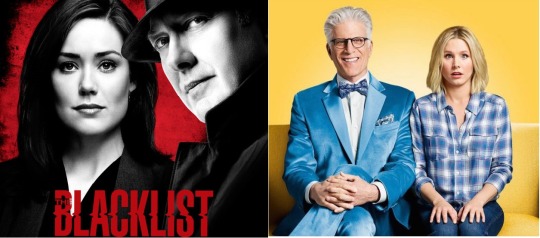
(Written Oct. 2018… pre-S6 of TBL and mid-S3 of the Good Place.)
NOTE: THERE WILL BE MAJOR SPOILERS OF BOTH SHOWS. DO NOT PROCEED UNLESS YOU HAVE SEEN THEM BOTH!!!!!!!
In case you haven’t, there is a spoiler-free version of this post here.
(Author’s note: So, if you’re reading this you may or may not have read the other version first. If you have, I’m basically going to be going over the same material with the same structure, with some of the text basically copy/pasted from the first version. But, where I held back on the spoiler-y details before, I’m now going to be going all out. I’ll reiterate: PLEASE DO NOT READ THIS VERSION UNLESS YOU HAVE SEEN BOTH SHOWS!!! Thank you.)
For any of you unfamiliar with my content, I’ve been analyzing different aspects of The Blacklist for the past few years, including calling attention to what I believe are flaws in its plotlines and characterizations.
This April, I happened upon The Good Place on Netflix and absolutely gobbled it up. I watched all of S1 in pretty much a single day; S2, in a similarly short time frame. Now, I’ve probably seen every S1 and S2 episode at least four times, and I’m watching the S3 episodes as they air on NBC before The Blacklist returns in January for its sixth season.
Now, it’s definitely not fair to compare The Blacklist and The Good Place. The former is an hour-long (44 minutes/episode) crime drama procedural that has had 22 or 23 episodes per season in five seasons. The latter is a half-hour (22 minutes/episode) ‘genre’ comedy set in the afterlife that has 13 episodes per season in three (ongoing) seasons.
So, TBL has an approximate 4,840 minute run-time, and TGP’s is approximately 858 minutes (including all of S3).
That means that The Blacklist’s overall runtime is almost SIX times the length of The Good Place.
Even so, both of these feature prominent TV actors, including Emmy Award winners James Spader and Ted Danson, respectively; both center on a relationship between a 30-something white woman and an older white man(whether that relationship is romantic, platonic or pseudo-familial is debated by fandoms of both shows); and both of these are NBC shows.
So, while it might not be exactly fair to compare these two shows, I’m going to do so anyway, because I feel like where the Blacklist struggles, The Good Place shines as a quality television program.
Now, don’t think for an instant that The Blacklist is a completely worthless show or that The Good Place doesn’t have its flaws. There are good and bad aspects of both shows, but I’m going to be comparing the two by focusing on three key things that make a TV show compelling:
Plot Progression
Character Interactions
Character Development
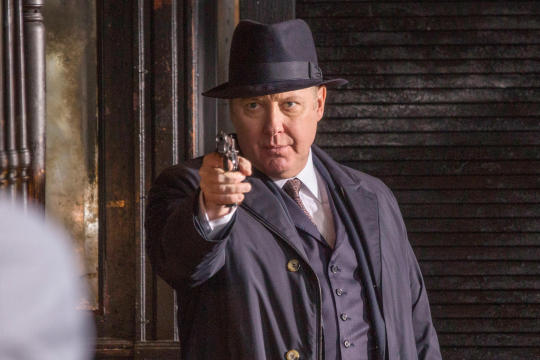
1. PLOT PROGRESSION
I think anyone who’s seen the Blacklist will tell you that this show’s plot is convoluted AF. In S1, it seemed like the show was setting Berlin up to be the show’s overarching Big Bad. But, then he gets killed off in S2 while the Cabal takes the forefront. The Cabal kinda hangs out until the end of S3, really, and then gets mostly forgotten until Ressler kills Hitchen in S4. And, Mr. Kaplan becomes Red’s enemy because she was once Liz’s nanny????
This show is so fucking weird.
It continues to frustrate me that all of the show’s major plot developments/revelations come during a mid-season or season finale, or a season or mid-season premiere. The Blacklist’s plot structure continually revolves around the idea of ‘sweeps week,’ when the network tries to boost its ratings by promising major reveals and developments during certain time frames.
Why not space some of these things out more instead of giving us what is essentially filler? We go along for the ride week after week, hoping to get clues or developments to the overarching story, only to be frustrated at the world’s slowest drip ever.
I feel like the first part of S5b really fell into this trap. It reveals to the audience shortly after Keen’s return that Ian Garvey is a dirty cop. And then we wait like 4-6 episodes (I don’t remember exactly how long) until Liz realizes this too. Jeez. Why drag it out so long?!?!
Now, I will say that the decision to kill Garvey in 5x19, rather than the season finale was a good idea. As it breaks the mold of having to wait until the (mid)season finale for the Arc’s Big Bad to finally bite it.
But, while that might’ve been a small victory, it still doesn’t make up for all the times this show has thought it was pulling the rug out when all it was doing was being predictable AF.
Between Liz “dying,” Kaplan helping her, Kirk being her stepdad, Mr. Kaplan being the one coming after Red, Tom dying, Liz trying to trick Red into revealing his secret by playing like she’s in danger and needs him to rescue her, the bones being the Real Reddington, etc... it continually frustrates me that folks here on Tumblr predict everything that’s going to happen with pinpoint accuracy. It makes the show boring and rote. (Not the folks on Tumblr; more the fact that this show’s plots are so predictable.)
Conversely, the Good Place – per the show’s creator Mike Schur – centers on the idea of subverting expectations. Based on the pilot’s premise, you might assume that the finale will be Eleanor revealing that she doesn’t belong in the neighborhood. But, Schur and his writing team have said multiple times that they focus on trying to make each episode end with a cliffhanger, and doing those big reveals or developments earlier in the season than the audience expects.

As Schur (or maybe some other writer or exec) recently said on the Good Place podcast, 2x09 “Best Self – where the crew leaves the Good Place to head to Bad Place HQ – feels a little like a season finale, despite the fact that there were three more episodes left in S2.
The Blacklist, IMO, also suffers from overdramatic promotions that sometimes make it seem like each episode is going to have some shocking development, when in fact, you could probably skip it and not really miss much (unless it’s a premiere or finale).
I feel like I remember the S2a promos about Liz hiding Tom in the boat, which of course, everyone predicted, really hyped up that reveal so that it was a real let-down whenever we finally got the truth.
TGP, on the other hand, doesn’t really have episodic promos like The Blacklist does, which might work in its favor. (Although, I will say that I was pissed the NBC Thursday night comedy line-up promos ruined the 3x01 Trevor reveal before the actual episode ended.)
I mean, compare how TBL handled the Boat Door Reveal in S2 versus how TGP handled the Michael-sacrifices-himself-to-save-Eleanor development. If TGP had done it like TBL’s, we would’ve known a week or two in advance that someone was going to sacrifice themselves to save Eleanor. It would’ve been these dramatic promos going like “Who! Will! It! Be?!?!!” with like pictures of all the cast members flashing by. And, of course, everyone would predict it would be Michael and/or Chidi, we would all be right and subsequently disappointed.
Also, while I feel like TBL tends to play things safe – very rarely breaking away from the crime drama procedural vibe – TGP doesn’t mind taking chances, so long as whatever they’re taking a chance on fits within the ‘world’ of the show.
If you haven’t seen my rant about TBL’s S5b, I was so excited after Liz woke from a coma to see how the show might tackle that plotline. Would Liz be traumatized? Would she be reluctant to rejoin the Task Force? What if she decided to give up her life with the FBI altogether and raise Agnes? What if she had PTSD? etc.
And, the show went the very predictable route of not showing much, if any, of Liz’s physical therapy or psychological trauma, and having her get back ‘out in the field’ (proverbially speaking) pretty much right away. She pawned Agnes off to Scottie and then kicked it in the woods for an episode.
Whereas, with The Good Place, we got to see major glimpses of Eleanor’s year after her near-death experience in 2x12. Granted, not much of it, but given the show’s time constraints and break-neck speed (in terms of plot development as opposed to TBL), it was nice that we got to see Eleanor become a better person, backslide, and then make a decision on whether she wanted to try to make progress again or whether she was going to stay in her rut forever.
Clearly, you can seen how one’s plot progression is preferable – as a viewer – to the other. It’s also helpful, I imagine, as a writer, to let the plots unfold organically, as fast or as slow as they need to… instead of having to either rush them or drag them out to reach a certain point in the season’s schedule.
2. CHARACTER INTERACTIONS
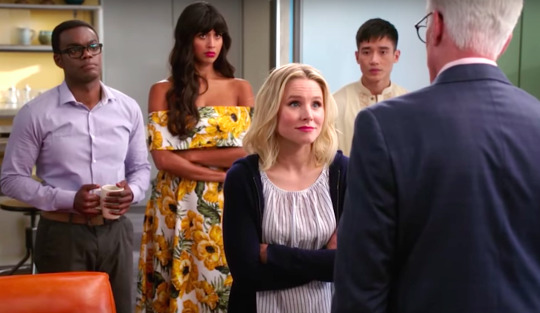
As said above, both shows focus on the connections between its male protagonist and female protagonists. While ultimately it’s the female protagonist’s journey, the male protagonist is a guiding force in her journey, helping her along and pushing her to make decisions (whether good or bad).
(Although, I guess you could argue that Chidi is really TGP’s male protagonist, but considering that Ted Danson is more heavily promoted, I’d argue Michael is really TGP’s male protagonist.)
And, for both shows, its two main protagonists are part of a six-person main cast.
For The Good Place, the cast is Eleanor and Chidi, Tahani and Jason (two other residents in Eleanor’s neighborhood), Janet (the neighborhood’s anthropomorphized mainframe/help desk), and Michael.
The Blacklist’s cast, as of the end of S5, is Reddington and Keen, her fellow agents Donald Ressler, Samar Navabi and Aram Mojtabai, and their task force director Harold Cooper.
Now, the Blacklist primarily focuses on the relationship between Reddington and Keen; he doesn’t interact with the other cast members very frequently and Keen’s interactions with them are pretty basic and often work-focused. There aren’t very many crucial interactions between non-Reddington/Keen pairings, especially in more recent seasons of the show. While S1 and S2 tried its best to have Keen interact with Ressler, Ressler interact with Reddington, Cooper interact with Reddington, Keen interact with Navabi, etc., S3-5 have more focused on the Reddington/Keen dynamic at the expense of everyone else.
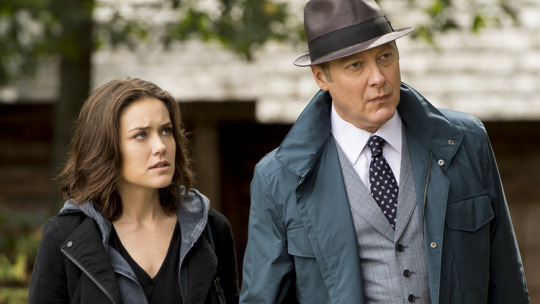
Granted, I like the Reddington/Keen dynamic (in some respects), but giving it more weight in the runtime unfortunately means that the remainder of the cast has to tackle the more procedural aspects by trying to track down the Bad Guy of the Week while Reddington and Keen get to have more of the character-driven serialized moments and developments.
Compare this, though, with TGP and its interactions outside of the Eleanor/Michael dynamic.
Throughout different points in S1 and S2, we got significant interaction between almost every single possible pairing of characters on this show. (And I mean pairing in a non-romantic sense.)
We see Eleanor fall in love with Chidi, become ‘mates’ with Tahani, become bros with Jason, and try to kill Janet and then later give her relationship advice. Meanwhile, Michael has his falling out with and subsequent heartfelt apology to Chidi; he admits to Janet that she’s his most loyal friend; in S1, he seeks out Tahani’s help; and in S2, he seeks out Jason’s feedback. Tahani and Jason’s romantic connection is explored, as is Jason and Janet’s. Chidi and Tahani have an important bonding moment in S1, and even the dynamic between Chidi and Jason is touched on some.
So, while TBL’s cast feels a little separated and almost cliquish, TGP’s six castmembers feel like a cohesive team where any two or three characters can be trusted to carry a scene and have an emotional connection/interaction. The former comes off as weak writing and show structuring, while the other is far preferable to watch.
3. CHARACTER DEVELOPMENT
As I’ve said in several other TBL posts, THIS is probably my biggest grievance with the show … even more so than the weird-ass plot structure.
Despite supposedly being major characters, Ressler, Cooper, Samar and Aram get very little in the way of growth or development. I can barely describe them, their personalities, their desires, their moral codes, etc. in maybe a paragraph for each character. And these are people who have been on this show for FIVE FUCKING YEARS!!! How is that possible that they’ve gotten so little development in so much screentime?
Again, remember, TBL’s runtime is SIX TIMES that of TGP. And yet, I feel like any and all of The Good Place’s major characters get way more development simply in the first season than TBL’s peeps do in five.
I could definitely describe Jason, Tahani, Chidi and Janet’s personalities, desires, moral codes, etc. in like a page for each character.
Now, granted, I suppose the show’s structure lends itself better to that. The characters have to do a lot of soul-searching, so to speak, in almost every episode. Whereas, the Blacklist’s cast has to chase down the week’s bad guys, which takes up at least 20-30 minutes per episode.
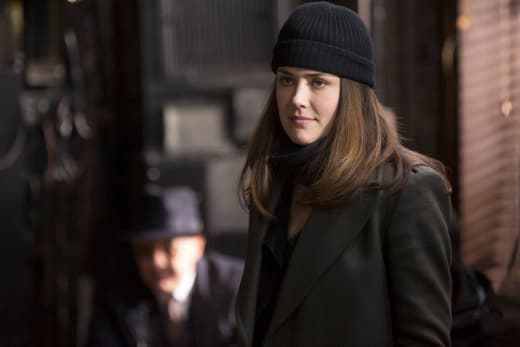
Okay, okay. Maybe it’s not fair, considering that TBL clearly doesn’t care about its non-Reddington/non-Keen characters. So, let’s focus on both shows’ two leads and their character arcs.
Let’s look at Reddington’s character development versus Michael’s.
Despite having much more screentime and weight within the show, Reddington’s arc PALES in comparison to Michael’s. Granted, Michael started out as a literal demon whose entire purpose was to torture people. But, over time, we saw his genuine curiosity about humans transform into a genuine desire to understand them and want to be one of them. Yes, he only seeks them out after 802 reboots because he feels he has no other options (thanks to Vicky threatening to blackmail him). But, as he learns ethics alongside the humans, he realizes he needs to become a better ‘person’ (read: demon) to better care of them. Because he OWES IT TO THEM.
Reddington’s character development, meanwhile, seemed to come more in the latter half of S4 when he was trying to deal with Mr. Kaplan coming after him and he was trying to confront this spectre of death that seemed to be looming over him.
Yet, even after all that bullshit with Mr. Kaplan, where he called him out for keeping secrets from Elizabeth that she had the right to know, he still held all the cards and kept his secrets to himself and killed anyone who got in the way.
If Red had really grown, the way Michael did in S2, he would’ve confessed to Elizabeth at some point that he wasn’t the real Reddington, that he stole her father’s identity, and he’d been keeping it from her all this time because of “x.”
While Michael has learned and grown as an individual, Reddington has stayed relatively static in terms of personal growth. Not to say we haven’t seen different sides of him, what he would do when he faced difficult scenarios, like Liz’s death or losing his criminal empire… but the Reddington in the S5 finale is too much like Reddington in the pilot episode. Which is absolutely ridiculous, given how much screentime and emphasis he’s gotten over FIVE SEASONS!!!
Michael has learned to admit when he’s been wrong, apologize and become a better friend to his humans, while Red still has yet to do Liz (a woman he loves immensely in some capacity or other) the basic kindness of telling her that he stole her dad’s identity.
Alright. Now let’s look at Elizabeth Keen versus Eleanor Shellstrop.
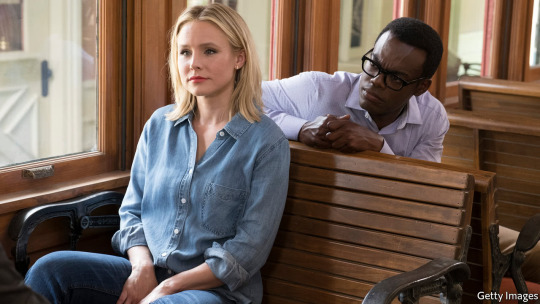
Both characters have suffered from character regression, where they start at Point A, then develop and grow over time to reach Point B, and then – for whatever reason – regress to Point A again.
Elizabeth Keen started out happy and bubbly in S1a, went to dark and gritty in S1b-3a, then went back to happy and bubbly in S3b to S5a, then back to dark and gritty again in S5b.
Eleanor started off as an Arizona dirtbag, then became a good person to the point where she decided to sacrifice herself by going to the Bad Place... then got rebooted 802 times... then started as an Arizona dirtbag again, progressed to the point where she was the only one of the four humans who passed her test from The Judge ... then was sent back to earth and was saved from death, so she decided to change her life, backslided and now is AGAIN trying to become a better person.
Now, while Eleanor’s character regression fits within the confines of the show, Keen’s makes no sense. She’s confronted and overcome so many challenges over the show’s the five seasons… so, why hasn’t she learned from them? Why is she still relatively the same, especially considering that x-number of seasons ago, she was so completely different?
Why is she back to being all angry and hateful and dark, etc., when it’s like... she has a young daughter who’s lost her father, she lost 10 months with her after being in a coma.... and she just wants to go beat up dirty cops??? I feel like if they wanted us to see an Elizabeth Keen that had learned from her experience, she would’ve given up her life with the FBI, saying that it’s put her in danger, severed ties with Red (or tried to) because he’s also endangered her (via the bones), and spent time with her daughter, whom she claims is more important than anything else in the world.
And, whereas Eleanor was not a very likable protagonist at the outset but she becomes more likable over time, Keen started out as somewhat likable but has become more annoying as her character continually regresses.
All in all, to quote (or at least paraphrase) some other Tumblr user, “I can’t believe The Good Place literally invented character development.”
TL;DR
Again, just to reiterate, I think there’s good and bad in both shows. But, there’s a reason why I’ve seen every episode of the Good Place at least four times and why TGP S1-2 is currently #4 on my list of All-Time Favorite TV Shows.
The Good Place pushes the envelope by subverting expectations and having major developments earlier in the season than expected; it makes sure that almost every character has significant moments with every other character; and it ensures that each of them has a major character arc that works within the confines of the show.
The Blacklist, in comparison, does what too many other shows on TV do: it treads water plot-wise; it focuses too much on some characters at the expense of others; and even the characters it focuses on don’t show any significant or organic growth.
And, that’s why, IMO, The Blacklist represents everything that’s wrong with television now; and The Good Place represents everything that’s right.
#the blacklist#the good place#nbc the blacklist#nbc the good place#tbl#tgp#lizzington#hellstrop#eleanor x chidi#michael x eleanor#eleanor x tahani#tahani x eleanor#eleanor x michael#chidi x eleanor#chidi x tahani#jason mendoza#tahani x jason#eleanor shellstrop#michael the demon#chidi anagonye#tahani al jamil#janet the good place#michael the good place#michael the architect#elizabeth keen#raymond reddington#harold cooper#donald ressler#samar navabi#samar x aram
50 notes
·
View notes